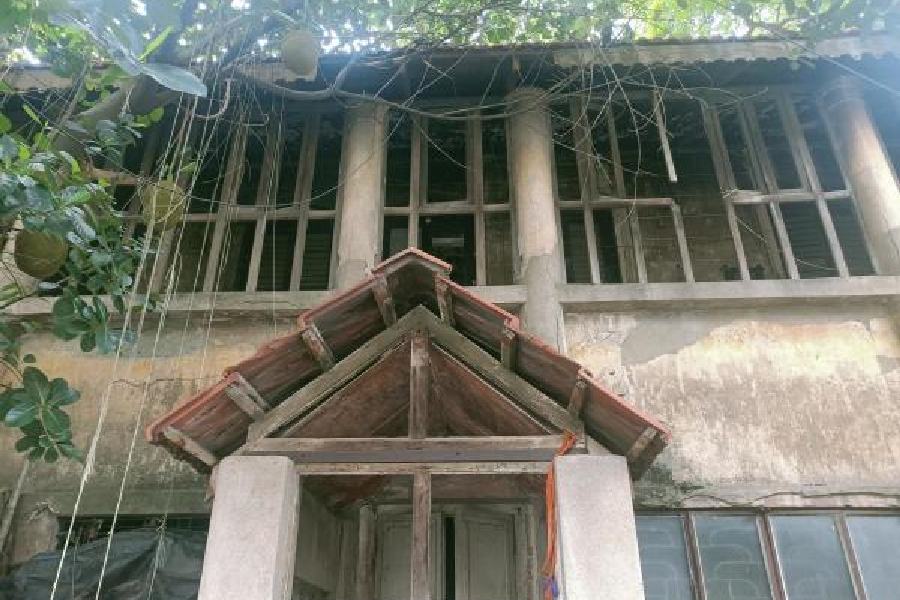Type “Dalgis Bungalow” in Google Maps and you will find nothing. But one of the prompts lined up reads, “Naktala dalgish banglow (sic)”. Click on it and the screen throws up a visual of a temple.
The Kali temple is actually part of what is the garden and main entrance to Dalgis bungalow, says septuagenarian Manju Ghosh who has been a resident of Naktala in south Calcutta for the last seven decades. Dalgis or Dalgleish is indeed a Scottish surname. Local lore has it that a Scotsman, a Mr Dalgis, a trader most likely, built the bungalow in what is now known as Shahid Nagar Colony.
Nobody knows anymore when and under what circumstances “Dalgis saheb” — as he is referred to — arrived in India and when he left. Older residents of the neighbourhood remember this house as the only building that stood tall in what used to be a vast stretch of marshy land — till about the 1950s.
Today, the same place is a bustling locality with schools, shops, a marketplace, residential complexes, standalone houses. “Dalgis saheb was not the zamindar of this place, but he lived like one. A few hundred metres away, he planted an orchard where grew mangos, litchis, jamuns, water-apples, aansh fol (longan), sooji fol,” says Pradip Dutta, 76, who is Manju’s younger brother.
He and his sister happen to be the current occupants of the bungalow and Pradip seems to think that that alone qualifies him as an expert on Dalgis history. He continues, “Saheb had a stable in the middle of the grassy land.” Then points to the annexe, which is a long row of single rooms and holds forth on “Saheb’s servants quarters”.
In effect, very little is known about Dalgis. Some say that the abandoned bungalow was first turned into living quarters for the British Army during World War II, and post 1947, the Bidhan Chandra Roy government turned it into a home for refugees — widows only and their children. This was possibly a common practice. Some might recall a Bengali short story by Lila Majumdar, Tepantarer dhaarer bari, about an abandoned house filled with phantoms of children, hungry, noisy, skeletal.
Manju and Pradip’s mother was one of the widows who sought shelter. Says Manju, “She had left East Pakistan with me and my 10-month-old brother. The government had initially accommodated us at the Gandhi Ashram. A year later we moved here.”
The bungalow is a two-storeyed structure with a huge verandah. The weather-beaten exterior walls are bereft of plaster and the bricks are exposed in places, cheeky, grinning. Roots and branches of peepal and banyan have snaked their way into the structure. Pradip recalls, “The verandah once had glass windows. We broke a few while playing cricket.”
Dalgis Bungalow is built over a bigha of land — one bigha equals 0.62 acres. There are four big rooms and three small rooms on the ground floor. A big room is as big as a modern-day two-bedroom apartment; the roof is very high and the walls are four times the thickness of walls of present-day constructions.
In the ground floor room, which is home to Manju and Pradip, there are two king-sized beds loaded with books and clothes. A study table has been laid out on another side of the room. The fireplace has been turned into a puja corner.
Back in the 1940s and 50s, 20 people used to stay on the ground floor. Says Manju, “In this very room lived four women — my mother Induprabha Dutta, Sarashi Ray and Sudha-mashi. I cannot recall the name of the fourth woman.” Induprabha used to work in the canteen of the Writers’ Building as an accountant. Sarashi Ray was a nurse. Pradip remembers the durwan who occupied a small room on the first floor. That floor is now inaccessible. The staircase has given in.
Over time, the other residents moved on. The widows died, the children grew up, got married, settled elsewhere. In the house from Majumdar’s story, on a dare, some boys with tiffin carriers loaded with kochuri, alur chat, jibegoja and kaanchkolar achaar spent one night in the “haunted” house. When they offered their goodies to their phantom friends, they wolfed it down and in exchange helped them win the dare. In the end, the house was cleansed of its ill reputation and the boys got ten bucks each. More importantly, Majumdar writes that once fed, the ghosts of the refugee children were released from their earthly shackles, their ghosthood.
Dalgis bungalow will be pulled down some day or the other, later or sooner. “It is a century-old building. To think somebody could repair it, give it a heritage status,” says Pradip and closes the door of the house with trembling hands.











